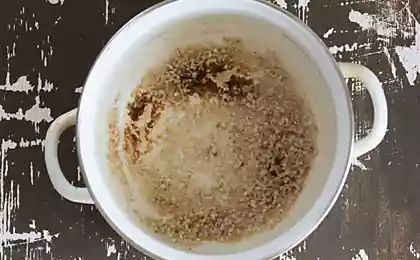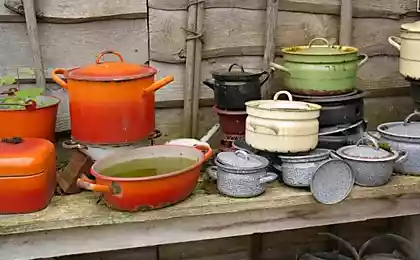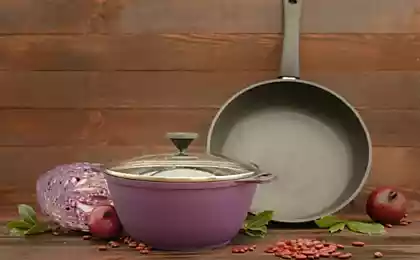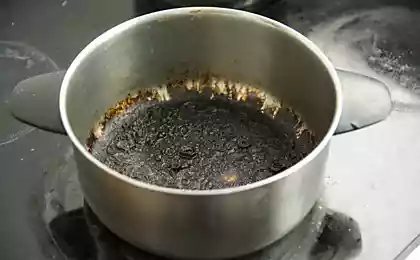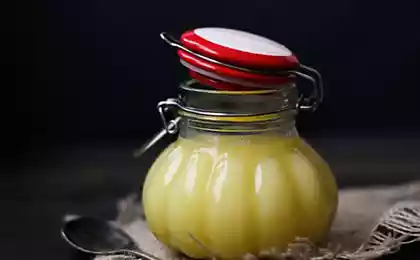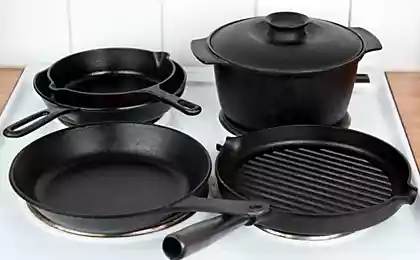495
Educational program for pots and pans
Two million eight hundred sixty four thousand three hundred eighty nine
1. Utensils made of aluminium
More than half of the pots and pans in the sale made of aluminium and are usually coated with non-stick layer. Scientific evidence that aluminum causes Alzheimer's disease, as once suggested by the researchers, was not found. Aluminium is in the air, water, soil, plants, animals, food and household items. If you want to minimize the impact of aluminum on the body, the best way to avoid medications containing antacids ( used to treat acid-related gastrointestinal diseases) and use deodorants instead of antiperspirants (do not contain aluminum).
For comparison: in 1 antacid tablet of 50 mg of aluminium, aspirin 10 to 20 mg. If you use aluminum cookware, in your body supplied 3.5 mg daily. However, if you store highly acidic foods (tomato sauce, wine, sauerkraut, lemon juice), and the excess of aluminium gets into the food and can harm the health. Besides, is being eroded the surface of the dishes.
Utensils made of aluminium with a protective oxide coating (anodized aluminium) with a non-stick effect scratch-resistant and easier to clean. Manufacturers claim that this layer protects the food against the penetration of aluminum. This cookware does not react with highly acidic products, so it is good to prepare food with wine, tomatoes, lemon juice etc.
2. Pottery
Forty eight million fifty two thousand one hundred seventy
The main problem — it contains lead that can migrate into food and cause severe poisoning. Particularly dangerous for children and pregnant women.
How to protect yourself:
— do not prepare or store the food in a clay pot
— if you did buy clay pots, cups, dishes, pots and etc., they should be marked "Safe for cooking". If it says "for decoration Only", "Only for ornamental purposes", do not use them for cooking.
— pottery is not exactly safe, if it remains gray powder after washing.
3. Cast iron cookware
Fifty seven million six hundred seventy nine thousand seventy
Time-tested classic, inexpensive and uniformly transmits heat for frying and baking. Cooking in cast iron also provides the body with essential mineral food after it contains 2 times more iron.
Cast iron pots and pans require special care. To prevent rust, the inner surface must be lubricated regularly unsalted cooking oil. It cannot be washed and cleaned with highly-active detergents and should be dried immediately after rinsed with water.
4. Copper cookware
Sixty million three hundred eighty seven thousand two hundred eighty five
Copper is an excellent conductor of heat delicate sauces on it ever burn, so it is so loved by the chefs of Haute cuisine. All the dishes that require precise control of temperature, is obtained in a copper bowl.
Usually covered with a layer of tin or stainless steel. If not, the copper reacts with food during cooking in large quantities may cause nausea, vomiting and diarrhea.
5.Cookware with non-stick coating
If you frequently for it to cook, deteriorating rapidly, the particles of layer can end up in food, but are removed from the body without harm to health. On high heat fry pan with non-stick coating starts to smoke, but the smoke is less toxic than smoke from regular cooking oil.
6. Stainless steel cookware
Eleven million nine hundred forty thousand four hundred eighty six
Durable, resistant to rust, stains, wear resistant, not easy to scratch. Stainless steel is combination of iron with other metals such as chromium, Nickel, molybdenum or titanium — it is added for strength and resistance to high temperatures, scratching and corrosion.
Due to the fact that stainless steel transmits heat unevenly, the bottom are usually made of copper or aluminum. Not recommended for how long to leave it sour and salty food. Threat to health is not responsible, but the acid and salt can damage the surface of the steel.
7. Ceramic and enamelware
Thirty eight million six hundred ninety thousand two hundred twenty one
Enamel coated iron and steel is resistant to stains and scratches, does not absorb food odors and does not contain lead, except for some coatings used for slow cooking. But even there, the dose is negligible and not harmful to health.In the seventies a potentially dangerous excess of cadmium were found in the pigments for painting the inner part of the enamelware. In modern manufacturing these pigments are not applied.published
Source: smart-cookie.ru/quality-of-food/likbez-po-kastryulyam-i-skovorodkam/
1. Utensils made of aluminium
More than half of the pots and pans in the sale made of aluminium and are usually coated with non-stick layer. Scientific evidence that aluminum causes Alzheimer's disease, as once suggested by the researchers, was not found. Aluminium is in the air, water, soil, plants, animals, food and household items. If you want to minimize the impact of aluminum on the body, the best way to avoid medications containing antacids ( used to treat acid-related gastrointestinal diseases) and use deodorants instead of antiperspirants (do not contain aluminum).
For comparison: in 1 antacid tablet of 50 mg of aluminium, aspirin 10 to 20 mg. If you use aluminum cookware, in your body supplied 3.5 mg daily. However, if you store highly acidic foods (tomato sauce, wine, sauerkraut, lemon juice), and the excess of aluminium gets into the food and can harm the health. Besides, is being eroded the surface of the dishes.
Utensils made of aluminium with a protective oxide coating (anodized aluminium) with a non-stick effect scratch-resistant and easier to clean. Manufacturers claim that this layer protects the food against the penetration of aluminum. This cookware does not react with highly acidic products, so it is good to prepare food with wine, tomatoes, lemon juice etc.
2. Pottery
Forty eight million fifty two thousand one hundred seventy
The main problem — it contains lead that can migrate into food and cause severe poisoning. Particularly dangerous for children and pregnant women.
How to protect yourself:
— do not prepare or store the food in a clay pot
— if you did buy clay pots, cups, dishes, pots and etc., they should be marked "Safe for cooking". If it says "for decoration Only", "Only for ornamental purposes", do not use them for cooking.
— pottery is not exactly safe, if it remains gray powder after washing.
3. Cast iron cookware
Fifty seven million six hundred seventy nine thousand seventy
Time-tested classic, inexpensive and uniformly transmits heat for frying and baking. Cooking in cast iron also provides the body with essential mineral food after it contains 2 times more iron.
Cast iron pots and pans require special care. To prevent rust, the inner surface must be lubricated regularly unsalted cooking oil. It cannot be washed and cleaned with highly-active detergents and should be dried immediately after rinsed with water.
4. Copper cookware
Sixty million three hundred eighty seven thousand two hundred eighty five
Copper is an excellent conductor of heat delicate sauces on it ever burn, so it is so loved by the chefs of Haute cuisine. All the dishes that require precise control of temperature, is obtained in a copper bowl.
Usually covered with a layer of tin or stainless steel. If not, the copper reacts with food during cooking in large quantities may cause nausea, vomiting and diarrhea.
5.Cookware with non-stick coating
If you frequently for it to cook, deteriorating rapidly, the particles of layer can end up in food, but are removed from the body without harm to health. On high heat fry pan with non-stick coating starts to smoke, but the smoke is less toxic than smoke from regular cooking oil.
6. Stainless steel cookware
Eleven million nine hundred forty thousand four hundred eighty six
Durable, resistant to rust, stains, wear resistant, not easy to scratch. Stainless steel is combination of iron with other metals such as chromium, Nickel, molybdenum or titanium — it is added for strength and resistance to high temperatures, scratching and corrosion.
Due to the fact that stainless steel transmits heat unevenly, the bottom are usually made of copper or aluminum. Not recommended for how long to leave it sour and salty food. Threat to health is not responsible, but the acid and salt can damage the surface of the steel.
7. Ceramic and enamelware
Thirty eight million six hundred ninety thousand two hundred twenty one
Enamel coated iron and steel is resistant to stains and scratches, does not absorb food odors and does not contain lead, except for some coatings used for slow cooking. But even there, the dose is negligible and not harmful to health.In the seventies a potentially dangerous excess of cadmium were found in the pigments for painting the inner part of the enamelware. In modern manufacturing these pigments are not applied.published
Source: smart-cookie.ru/quality-of-food/likbez-po-kastryulyam-i-skovorodkam/


